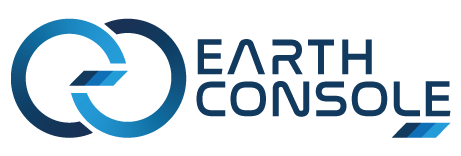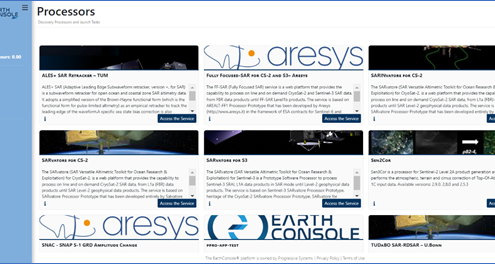EarthConsole® selected as service provider for two OCRE funded research projects
EarthConsole® by Progressive Systems was chosen as the preferred service provider for two research projects awarded through the OCRE (Open Clouds for Research Environments) call for funding Earth Observation services. These projects required extensive processing campaigns for different objectives using processors from the SARvatore (SAR Versatile Altimetric TOolkit for Research & Exploitation) family of processors. These processors were integrated by Progressive Systems into the ESA Altimetry Virtual Lab on the EarthConsole® platform in 2021, following the previous ten-year experience as RSS G-POD operator at the European Space Agency.
With this long-term processing heritage, EarthConsole® was the clear choice for the research institutions leading the projects. In this blog post, we’ll delve into the details of these exciting projects and how EarthConsole® plans to contribute to their success.
The supported projects
Project: CryoSSARinSAM+
Research Institution: Technical University of Denmark – DTU SPACE (Denmark)
The Polar regions are important to study for a number of reasons. In an era of climate change, melting ice is expected to accelerate sea level change. In the past, various research groups have processed the first 9 years (2010.07-2020) of Cryosat radar altimetry for the Polar Oceans independently, using EarthConsole® or using the G-POD On Demand platform computing services. To continue this vital timeseries up through 2023 and also extend the Polar regions coverage to all regions outside the 50 degree parallel, this project was established.
CryoSSARinSAM+ aims at developing a common processing chain configuration to produce a single, open-access CryoSat-2 altimetry mission dataset that can support radar altimetry research of the polar oceans (both for the northern and southern hemisphere).
This dataset will have a wide range of potential applications, such as studying sea level, circulation, and trends in ice-covered polar seas; improving algorithms to monitor coastal sea level; estimating the thickness of summer sea ice; measuring significant wave height in polar oceans; and enhancing measurements of winter sea ice thickness in the Arctic and Antarctic, among other.
We want this dataset to become a reference standard for the radar altimetry research community, playing a pivotal role in advancing our knowledge of the polar oceans and ice cover, and the impact of climate change on them. A number of research institutions have been onboard designing this study and will directly ingest these data in their ongoing research
Ole B. Andersen
Professor, Department of Space Research and Technology
Geodesy and Earth Observation
DTU SPACE
Project: Assessment of renewable wave energy resources in the coastal zone using high-resolution altimetry products
Research Institution: CENTEC (Centre for Marine Technology and Ocean Engineering), Instituto Superior Tecnico , (Associação do Instituto Superior Técnico para a Investigação e Desenvolvimento) – IST-ID, (Portugal)
The project’s primary objective is to evaluate the potential of wave renewable energy sources in the Atlantic Ocean, with a particular emphasis on the coastal region, where the energy can be efficiently harnessed. To achieve this objective, the project is processing the whole CryoSat, Sentinel-3A, and Sentinel-3B missions data over specific coastal zones and using an improved geophysical retrieval algorithm: SAMOSA+ (Dinardo et al. 2018, Dinardo 2020).
The datasets generated through this project are expected to have a multitude of applications, ranging from evaluating renewable energy sources to gaining a better understanding of the impact of waves on the rise of sea levels. We want this project to benefit the whole altimetry research community, this is why the findings will be shared as we complete the project
Sonia Ponce de Leon A.
Assistant Researcher
CENTEC-IST-University of Lisbon
Why EarthConsole®
EarthConsole® has been selected as the optimal service provider to perform the processing activities requested by the projects.
With the ESA Altimetry Virtual Lab (AVL) hosted on the platform, EarthConsole® provides the necessary services and solutions to cater to the specific needs of the altimetry research community.
The ESA Altimetry Virtual Lab is hosting SARvatore for CryoSat-2, SARINvatore for CryoSat-2, and SARvatore for Sentinel-3 processors, among others. These processors will be used to reprocess CryoSat-2 altimetry mission data (CryoSSARinSAM+) and Sentinel-3A & Sentinel-3B data (Assessment of renewable wave energy resources in the coastal zone using high-resolution altimetry products) on specific areas and periods of interests indicated by the research institutions.
EarthConsole® utilizes flexible computing resources such as Worker Nodes, CPU, and RAM, in combination with a quick access to data on a Copernicus DIAS infrastructure. This minimises the impact of data transfer on processing time, enabling scalable processing campaigns to be completed within the projects’ time constraints.
In addition, EarthConsole® experts will oversee all processing activities, freeing up researchers from the task of managing the processing campaign and IT infrastructure, allowing them to focus on their research goals.
In conclusion, EarthConsole® has once again demonstrated its commitment to providing innovative solutions that add value to altimetry research. With the needed processors, flexible computing resources, the quick access to the Copernicus datasets, and the right expertise, researchers can confidently pursue their research objectives, knowing that they have a reliable partner to support their efforts.








